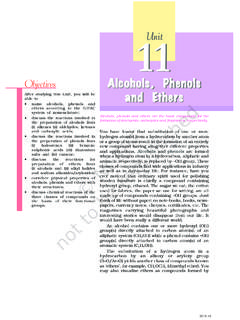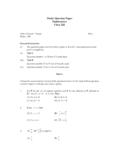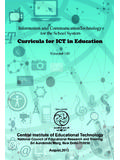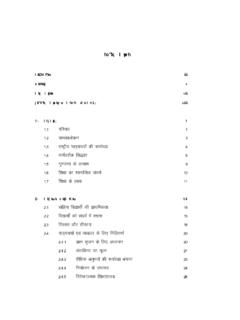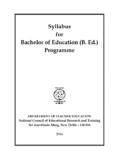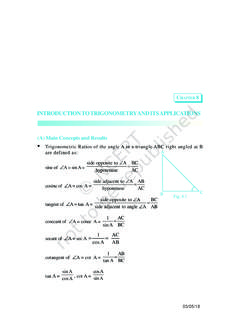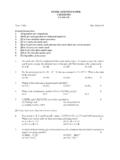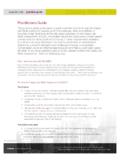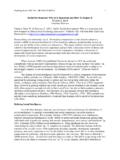Transcription of MODULE 4: UNDERSTANDING ADOLESCENCE …
1 IMPORTANT: Provide your feedback after reading this MODULE . The feedback link is provided on the last page of this MODULE . Please note that you have been provided with a different link for each MODULE you review. MODULE 4: UNDERSTANDING ADOLESCENCE . Activity 1: We Are Changing! Learning Objectives: To enable learners to: Accept that change is an inevitable part of life Appreciate that growth and development is a continuous process Time required: 30 minutes Material required: Writing board and chalk/ markers OR index cards and a soft-board Notes to the facilitator: This activity can be conducted in a large group with all the learners. Ensure that all learners participate in this activity. Draw five columns on the black board with the headings infancy, childhood, ADOLESCENCE , adulthood and aged as shown in the table below. Alternately, if you are using a soft board, you could make index cards that depict the five different stages of life as shown in the table.
2 Ask the learners to categorize the changes according to the stages of life when they occur, from the time that one is born till one becomes an adult and grows old. The changes could be recorded on the black board or on the index cards/ slips of paper and pinned on the soft board. In case, learners do not respond, you could provide the following list of changes to initiate the activity: for example, growth in height, learning to talk, learning to walk, menarche, getting a beard, going to school, voice breaking, becoming shy, becoming responsible, osteoporosis (weakening of bones), being economically independent, menopause etc. Please note that some changes may continue through more than one stage of life (for example, being economically independent) and that all changes may not occur in all individuals (for example, boys will not get menstrual periods).
3 Please stop the listing when the learners have listed approximately four to five changes in each phase of life. Changes During Different Phases of Life Infancy Childhood ADOLESCENCE Adulthood Aged Please remember to provide feedback at the end of this MODULE Summing Up: The facilitator may sum up the discussion emphasizing the following issues: The world is a changing place. We may find changes exciting and good or scary and painful. Sometimes we can influence changes in our lives and at other times we have no control over them Some of the changes in our lives are predictable. If we are prepared for them, we may be able to influence some of these processes and manage them better. For example, growth and maturation is a continuous process and ADOLESCENCE is a stage in the continuum of growth and development across the life span Adolescents need to be prepared for the physical, mental, psycho-social and emotional changes that take place during this phase of life so that they are not anxious about them and respond to these changes in positive and responsible ways Activity 2: Differences in maturation process during ADOLESCENCE and effect on body image Learning Objectives: To enable learners to: Recognize that changes during ADOLESCENCE occur at different pace and timing in every individual Develop a positive acceptance of self Time required: 60 minutes Material required: Copies of the case studies Notes for the facilitator.
4 Divide the class into groups of five-six learners each Each group will work on one case study Appoint a reporter in each group Give the group ten minutes to read the case study and discuss it Ask each group reporter to share the views of the group on the case study assigned to them based on the questions for discussion Case Study 1. Rakesh and Mihir, students of Class XI, are walking home together from school. Rakesh begins to tease Mihir, saying that he speaks in a girl's voice. He also laughs at the fact that Mihir has got no hair on his upper lip. Look at me , Rakesh says, I am a real man. My voice is strong and my face is manly - I have so much facial hair. My father calls me sher. This really embarrasses 2. Please remember to provide feedback at the end of this MODULE Mihir. He recalls that his mother still calls him my sweet boy'.
5 He decides to go home and ask his mother why he is so different from Rakesh and whether something is wrong with him. Discussion Questions 1. Although they are of the same age, why do Rakesh and Mihir look so different? 2. Do you think that there is something wrong with Mihir? Why? 3. How do you think Mihir feels about himself? 4. What should Mihir's mother tell him? Case Study 2. Pushpa, Sujatha, Abida and Radha are good friends. All of them are 13 years old and love to spend time with one another. They have so much to talk about, the new film, the new dress, home work, the boys in the class and just about everything . Yesterday, Radha seemed uncomfortable. She was having her periods and was concerned about staining her uniform. Last month, Sujatha's family had organized a big celebration in her honor as she had started her periods.
6 Pushpa recollected that 3 months ago, Abida had started her periods in school and had to borrow a sanitary napkin from her older cousin. Pushpa is worried. Except her, all her friends had started their periods. Was something wrong with her? Discussion Questions 1. If Pushpa came to you for advice, what would you tell her as a peer? 2. In your opinion, who should be responsible for sensitizing adolescents about the fact that it is natural for different people to attain maturity at different times? 3. Do you think it is important for young people to be prepared for the changes that they are likely to face in ADOLESCENCE ? Why? 4. Discuss some of the reasons for celebrating menarche (starting periods)? Case Study 3. Robin is in Class XI. He is the smallest boy in his class. Although he likes to play football, he is never selected for his school team.
7 He is quite swift and skilful, but the coach always rejects him saying that he will get pushed around by the other players, who are much bigger than him. One day, on the roadside, Robin sees an advertisement outside the tent of a travelling medicine-man (quack). It shows a thin, weak looking boy in one picture and a muscular glowing man in another. The advertisement claims that a magic drug can bring about this transformation. Robin wants to try this drug, but is scared. 1. Why do you think that Robin is different from the other boys in his class? 3. Please remember to provide feedback at the end of this MODULE 2. Do you think that Robin can be a good football player and that the coach should give him a chance? 3. Do you think that Robin should take the magic drug which claims to make one muscular and strong? What are the possible effects of this drug?
8 4. If you were in Robin's place, what would you do? Case Study 4. Shalini and her friends in class 9 were preparing for the school's annual function. All of them were very excited. Anita, one of Shalini's classmates mocked at her, You are so dark. We will need additional light to be able to see you on the stage.. Shalini's good friend, Madhu felt bad for Shalini and advised her to use a cream to make her complexion lighter. You already dance so well. Can you imagine how nice you will look on the stage if you had a lighter complexion? . Shalini smiled and said, Thank you, Madhu. I appreciate your concern but I am happy with my complexion. My teacher and I are working hard on my dance practice and I am confident that our efforts and your good wishes will lead to a good performance.. Discussion Questions 1. What do you think of Anita's remark about Shalini?
9 2. Do you think that having a light complexion is important for being beautiful? 3. Do you think that Madhu is trying to perpetuate the stereotype that having a light complexion is an important component of being beautiful? 4. What do you think of Shalini's response? Summing Up: From the discussion on these case studies, the facilitator must elicit adolescents' feelings about growing up The facilitator should emphasize that while everyone matures and goes through the changes in ADOLESCENCE , this does not take place at the same time and in the same way for everyone Some people mature early, others mature later. Also, all changes related to ADOLESCENCE (physical, psycho-social and cognitive) do not take place at the same time. As a result, two adolescents of the same age may look very different. It is also possible that physical changes may take place early, but psycho-social changes take place later in the same individual.
10 As a result, the adolescent may look very grown up, but may continue to think and behave like a child 4. Please remember to provide feedback at the end of this MODULE Often, adolescents feel inadequate because they look different from their peers. This could be because they are maturing too fast or slower than others. This difference often becomes the focus of teasing and ridicule among peers, leading to the experience of shame and fear There are a lot of myths and beliefs attached to the growing up process, which need to be discussed In addition, there are a lot of harmful or ineffective products which claim to increase height and muscle mass very quickly, without any additional input of diet and exercise. Adolescents are drawn towards these products because they feel that these will enable them to hasten the growing up process.
